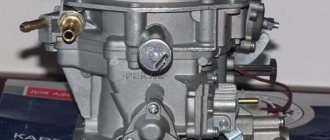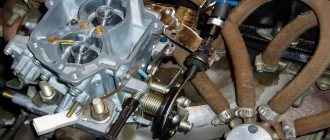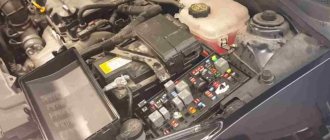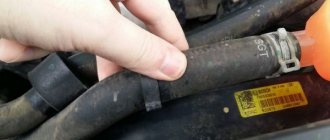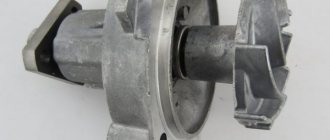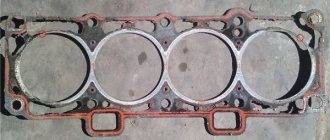How to properly configure a VAZ-2109 carburetor
The majority of VAZ cars of the Samara family, and in particular the VAZ-2109, came off the assembly line with a carburetor power system, and only later a small series received injectors. The carburetor system has a simple design and is quite reliable, but its main component, the carburetor, requires periodic adjustment. The VAZ-2109 and other models of the family were equipped with Solex carburetors, characterized by a relatively simple adjustment technology that every car enthusiast can perform.
There are two main carburetor settings - the fuel level in the float chambers and the engine speed at idle (idle). These adjustments are carried out when the engine is unstable at idle and when certain symptoms of improper operation of the power system appear:
These problems indicate that the fuel level in the chamber is not normal.
VAZ 2108 engine: characteristics, malfunctions and tuning
The popular VAZ 2108 model was equipped with time-tested four-cylinder gasoline engines with an overhead camshaft. These engines, depending on their specific modification, had a displacement of 1.1 liters, 1.3 and 1.5 liters. The most widespread was the 1.3 liter VAZ 2108 engine, which was economical and provided the car with good dynamics. We will tell you about the features of this engine, as well as what kind of engine can be installed in a VAZ.
Specifications
Characteristics of the 1.3 liter VAZ 2108 engine:
| PARAMETER | MEANING |
| Years of manufacture | 1984 – 2004 |
| Weight | 127 kg |
| Cylinder block material | cast iron |
| Supply system | carburetor |
| Type | in-line |
| Working volume | 1.3 |
| Power | 64 horsepower at 5600 rpm |
| Number of cylinders | 4 |
| Number of valves | 2 |
| Piston stroke | 71 |
| Cylinder diameter | 76 |
| Compression ratio | 9.9 |
| Torque, Nm/rpm | 95 Nm / 3400 |
| Environmental standards | EURO 2 |
| Fuel | AI 93 |
| Fuel consumption | 8.2 l/100 km combined cycle |
| Oil | 5W-30 – 15W40 |
| Oil volume | 3.5 liters |
| When replacing, pour | 3.2 liters |
| Oil change is carried out | 15 thousand km |
| Engine life - according to factory data - in practice | 120+ 200+ |
This motor is installed on:
Peculiarities
A 1.3-liter gasoline power unit appeared in the production line of the Volzhsky Automobile Plant in 1984. This motor used a number of technological innovations and was partially controlled electronically. This made it possible to improve engine power and also had a positive effect on fuel efficiency.
The VAZ engine power is 64 horsepower and the torque is 95 Nm. Unlike its predecessors, this power unit was originally designed to use 93 octane fuel.
Modifications
In its initial modifications, this unit had a carburetor power system and only in the late 90s it received a modern injector. The latter made it possible to provide the car with improved dynamics, and maximum traction was achieved at low revs.
The use of the injector also had a positive effect on fuel consumption, which on average began to consume less than 7 liters on the highway.
Among the advantages of this modification of the power unit, we can note the simplicity of the VAZ 2108 engine, which had a positive effect on its reliability and maintainability. This especially applies to carburetor modifications, the repair of which could be carried out by the car owner himself.
Unlike the 1.5 liter VAZ engines, this engine had a belt drive, which forced car owners to carry out service work every 50 thousand kilometers. With proper and careful operation, the service life of this engine reaches 200,000 kilometers.
The small engine turned out to be quite compact, and the use of aluminum for the cylinder head made it possible to reduce its weight. At the same time, the cylinder block itself is cast from cast iron, which improves the temperature stability of the engine.
Despite its small volume, this engine endowed the eighth VAZ model with excellent dynamics. The car's cruising speed was 120 kilometers per hour, and the engine itself worked primarily in tandem with a five-speed gearbox. This transmission became a novelty on VAZ cars and was very popular among buyers.
Flaws
Like any other model of power units from Tolyatti, the VAZ 2108 engines were not without shortcomings.
- For example, car owners quite often encounter wear and tear on the cooling system. The pump and thermostat could break down with regularity every 20,000 kilometers.
- It is also necessary to note the absence of hydraulic compensators, so the valve adjustment procedure was carried out every 10,000 kilometers.
- It should also be noted the mediocre reliability of Solex carburetors. Subsequently, carburetors of this type were replaced with a new, more reliable modification. With age, ignition problems could arise.
- It should be noted that this power unit has increased requirements for the quality of the oil and gasoline used. While most other VAZ modifications of power units could easily run on low-octane gasoline, this engine quickly failed when using 76 gasoline. The same applies to the quality of the oil. It was recommended to replace it every 15 thousand kilometers.
Malfunctions
| FAULTS | CAUSES AND REPAIRS |
| The engine does not start well and a characteristic shudder appears. | This engine has ignition problems, and if there are problems with the engine's operation, the ignition must be installed correctly. |
| Oil leaks appear after the car is parked. | The weak point of this engine is the valve cover seal. In this case, the repair consists of replacing the gasket. |
| The appearance of pronounced detonation. | If such detonation occurs when using high-quality gasoline, it is necessary to replace the fuel filter. |
| While driving, a sharp knocking sound appeared, after which the engine would not start. | This is typical for a broken timing belt. The design of the VAZ 2108 engine is such that if the timing belt breaks, the valves bend. Repair in this case consists of replacing valves and other damaged elements. |
Tuning
Due to the small displacement, increasing the power of the VAZ 2108 engine is a certain difficulty.
- Many car owners of the version with a carburetor installed an injector, which allowed them to get about 10 horsepower.
This engine does not involve boring the cylinders and installing additional reinforced elements. We also do not recommend that you try to increase the power of this engine by installing a turbine. Such tuning of the VAZ 2108 engine invariably reduces the life of the power unit, so such a turbocharged engine may need major repairs after 50-70 thousand kilometers.
- If you do not have enough power, it is possible to install a modified 1.5 liter engine in the engine compartment. Such an engine swap will allow you to get a VAZ engine power of around 100 horsepower. An experienced motor mechanic will tell you which engine can be installed in a VAZ.
dvigatels.ru
Setting the fuel level
Adjusting the amount of fuel in the chambers of Solex carburetors is a simple procedure and does not require specialized equipment. Although in the factory this adjustment is performed using a special template, which simplifies and speeds up the work. But at home you can do without this template. To carry out adjustment work yourself you need:
- screwdrivers (phillips, flat);
- ruler (preferably a caliper);
- round rod with a diameter of 2 mm (wire or drill will do).
With such equipment you can quickly complete all work.
Design
Exterior
Rear view
Initially, the car was produced with a so-called “short” front wing, but this turned out to be impractical, since the plastic trim on the front quickly “moved away” from the wings and became deformed from exposure to the sun. Beginning in 1991, a new front end design was developed, with fenders and a longer hood. In addition, the false radiator grille has changed, which gives the car a more modern look (facelift).
Interior
From the beginning of production, the car was equipped with a “low” instrument panel. Since 1991, the VAZ-2108 began to install a “high” instrument panel, which was distinguished by the presence of a tachometer and the absence of a voltmeter, as well as modified ergonomics.
Recommended Method
Level control technology includes a number of stages:
- We dismantle the housing of the air filter element. To do this, unscrew the fastening nut of the housing cover, unclip the latches, remove the cover, take out the filter and tighten the 4 nuts that secure the housing to the carburetor.
- Raise the body and disconnect the rubber pipes. We move the body to the side.
- Loosen the clamps securing the fuel pipes going to the carburetor and disconnect them.
- Remove the wire suitable for the idle speed solenoid valve;
- Disconnect the drive cable of the air damper (the “choke” handle);
- Unscrew the 5 screws securing the carburetor cover;
- Having removed the cover, we immediately determine the fuel level in the chambers by lowering a ruler or caliper into one of them until it stops (using its depth gauge). If the measurement shows a level of 25-26 mm, it corresponds to the norm and no adjustment is required;
Notes
- Astapenko, Alexander
.
The history of the legend: how the famous G8 was created, autonews.ru
(September 9, 2011). Retrieved March 14, 2020. - “Retro fitting”: we drive a three-door VAZ-2108, restored by an employee of “Autoreview” (unspecified)
.
"Autoreview"
. — “AR” No. 12 2020. Date of access July 6, 2020. (subscription required) - AvtoVAZ stopped production of the G8
- “Behind the Wheel”, No. 4 1985
- (cooperation between VAZ and Porsche) (unspecified)
. Retrieved January 12, 2012. - V. Popov. New VAZ model // Izvestia, No. 146 (20857) dated May 25, 1984. p.6
- Yearbook of the Great Soviet Encyclopedia, 1985 (issue 29). M., “Soviet Encyclopedia”, 1985. p.41
- Newspaper “Behind the wheel of St. Petersburg” No. 01-02 (296-297) February 2014 p. 34.
- magazine while driving (undefined)
. - Porsche storyline (unspecified)
(unavailable link). Retrieved February 15, 2020. Archived February 15, 2020. - “Behind the Wheel”, No. 4 1991
- V. Arkusha.
Our “Gran Turismo”
(undefined)
.
Magazine Behind the Wheel, No. 5, 1989
(May 1989). - Newspaper “Behind the wheel of St. Petersburg” No. 01-02 (296-297) February 2014.
Alternative way
There is a simpler method for determining the correct position of the floats, which does not require measurements. Place the carburetor cover on a flat table and look at the stampings made on the side surfaces. When the floats are in a normally adjusted position, these strips are parallel to the lid.
Then we lift the floats up and look at their bottom, which after lifting should be parallel to the surface of the lid. If necessary, adjust the position of the floats by bending the tongue.
After adjustment work, we assemble the carburetor.
Idle speed adjustment
The second setting of the VAZ-2109 carburetor is idle speed, it can be partial or full. The first is for minor speed adjustments, the second is for adjusting the amount of air (setting CO emissions in the exhaust gases).
Partial adjustment is performed using the air-fuel mixture “amount” screw. This screw sets the opening angle of the throttle valves, which ensures that the air-fuel mixture enters the cylinders when the accelerator pedal is released. The “quantity” screw rests on the throttle valve control lever and when screwed in, it pushes the lever, causing the valves to open slightly.
Partial idle adjustment is performed with a warm engine and creating a load on the vehicle's on-board network by turning on the high beam headlights and the interior heater at full power. The adjustment is carried out with the engine running by screwing in/unscrewing the “quantity” screw until the optimal idle speed is established, which for the VAZ-2109 is 800-900 rpm (this can be tracked using a standard or plug-in tachometer).
If it is not possible to set the required speed or the motor operates unstably at it, a complete adjustment is made, which is made by two screws - “quantity” and “quality”.
The algorithm for this adjustment consists of the following stages:
- Warm up the engine and then turn it off;
- We find the quality screw (it may be closed with a plug that will have to be removed), screw it in until it stops, and then unscrew it 3-4 full turns;
- We start the engine, turn on electrical consumers (lighting and stove) to create a load in the on-board network;
- By rotating the “quantity” screw, we achieve 700-800 rpm on the tachometer;
- By turning the “quality” screw, we set the maximum possible speed (they will increase to a certain level, and then stop. The moment the speed increase stops is considered the maximum);
- We set the “quantity” screw to 900 rpm;
- Using the “quality” screw we lower them to 800 rpm;
- We slowly tighten the “quality” screw until interruptions appear in the operation of the power plant, after which we unscrew it back 1 turn;
- We adjust the speed with the “quantity” screw, bringing it to a normal value - 800-900 rpm;
After the adjustment operations, we check that they were carried out correctly. This is done by sharply pressing the gas pedal and then quickly releasing it. With a properly configured carburetor, the engine should respond quickly to pressure, without any failures or hesitations. And after releasing the pedal, the speed will drop to the idle level, without sags or instability of the engine.
Video: HOW TO CORRECTLY ADJUST THE FUEL LEVEL
How to adjust the carburetor on VAZ-2109 and 21099 cars with your own hands
On all cars of the “ninth” family, the engines were equipped with domestically produced Solex carburetors. The only exceptions are later modifications, on which the manufacturer installed injection power units. Although far from being the most technically advanced vehicle, the Nine is still popular among car enthusiasts. This is largely due to the car’s maintainability and the relatively low cost of spare parts. In addition, a significant part of the restoration and adjustment work can be carried out by the owner himself, including adjusting the VAZ-2109 and 21099 carburetor, tuning it and cleaning it.
This article will consider only those operations that every car enthusiast can perform with his own hands. Don’t be intimidated by the large number of manipulations - follow the instructions, be careful, and setting up the VAZ carburetor will go no worse than in a service station. This way you can save time and reduce machine maintenance costs.
You can clean and adjust the carburetor for the VAZ nine yourself, in the garage
Preparing the carburetor for tuning
Before you begin adjusting the VAZ-2109 carburetor and other modifications of the model, you should ensure unimpeded access to its parts by removing contamination. If the car is used regularly, then the carburetor needs external flushing only in the case of adjustment procedures or to clean the moving mechanisms if they are heavily contaminated. External washing is carried out using a brush, a clean rag and a liquid that can dissolve oil (gasoline, kerosene or a special cleaning composition). This procedure does not involve removing the carburetor and consists of the following operations:
The market offers special means for cleaning the device - in the form of sprays
- cleaning and washing the outside of the carburetor;
- freeing the float chamber strainer from contamination;
- removal of possible contaminants and foreign particles from the float chamber itself;
- cleaning the jets from possible deposits;
The car owner should not have any questions regarding external cleaning, but as for how to clean the carburetor on a VAZ-21099 from the inside, this issue should be considered in more detail. In this particular case we are talking about the float chamber. First you need to dismantle the air filter and remove the fuel hose. After the float chamber is dismantled, it is better not to touch the float itself, so as not to deform or damage the part. Also, do not turn the carburetor cap upside down.
Important points
- Before adjusting the carburetor, it is recommended to self-clean it. To do this, a special liquid for cleaning carburetors is poured into the gas tank, the engine starts and runs (the volume of liquid poured and the engine operating time are always indicated on the container with the cleaning liquid and depend on the specific brand). Sometimes this measure is enough to get rid of the above signs of carburetor malfunction and do without fine adjustments.
- If self-cleaning does not help, there is only one way out: you need to remove and wash the carburetor. For washing, both special liquids and ordinary kerosene are used. It is strictly not recommended to use brushes or fluffy rags to remove dirt. Hairs and lint remaining in the small holes of the carburetor can negate all efforts to clean it. The best option: thorough rinsing in a special liquid, and then blowing out all small holes with compressed air.
- Before removing the carburetor and cleaning the inside, it is recommended that the outside be thoroughly cleaned. Moreover, it is necessary to clean not only the carburetor itself, but also all the parts located next to it. Please be aware that any dirt left on adjacent parts may find its way into the clean carburetor when it is installed back into the engine. And if this happens, the entire cleaning procedure will have to start again.
In order for the carburetor to work correctly, attention should be paid not only to its adjustment, but also to cleaning. If any of these procedures are neglected, the carburetor will soon fail again. In addition, attention should be paid not only to the quality of gasoline, but also to the condition of the car’s air filter, since in some cases it is a worn filter that causes rapid contamination of the carburetor.
- Author: Alexey Stepanov
Copywriter with five years of experience. Rate this article:
- 5
- 4
- 3
- 2
- 1
(3 votes, average: 4 out of 5)
Share with your friends!
How to set up a VAZ-2109 and 21099 carburetor in a garage
According to the recommendations of experts, adjustment of the VAZ-21099 carburetor should begin with the float chamber. Using this procedure, it is possible to check and establish the optimal fuel level. You need to configure it by following the steps below step by step:
- Start the engine and turn it off after 2-3 minutes;
- After the air filter has been removed and the fuel hose has been disconnected, remove the carburetor cover (to do this, you need to unscrew five bolts). Place the lid on a clean surface with the floats facing up, being careful;
After removing the air filter, disconnect the fuel supply and remove the carburetor cap
- Using a caliper, determine the fuel level in the float chambers: the distance between the edge of the housing and the upper level should be 25.5 mm. If it turns out that the measurements do not comply with the standard, you will have to make an adjustment by bending the tongue of the float bracket and re-measuring the fuel level;
Additionally, you can check how the edges of the floats are located relative to the mating surface of the cover and, if they are not parallel, adjust by acting on the float brackets.
How to adjust the throttle valve actuator
Before you begin adjusting the damper itself, you should check the degree of cable tension. If it turns out that the cable is slack or its tension is too strong, then adjusting the VAZ-21099 carburetor involves starting to adjust the drive in such a way as to prevent the damper from completely closing. To do this, use a wrench set to “13” and tighten the end nut on the cable sheath. Next, use the same key to gradually loosen the locknut.
1 – cap; 2 – lock nut; 3 – cable nut
Now you can set the optimal distance between the carburetor and the tip of the nut. It should be taken into account that in the free position of the accelerator pedal, the damper must be completely closed. All that remains is to tighten the nut and the setting can be considered complete.
How to adjust the air damper actuator
First, the free movement of the thrust must be checked - this will require dismantling the air filter cover. The drive settings can be considered correct only if the air damper is fully opened in the “recessed” position of its handle. If deviations from the norm are detected, read the instructions on how to adjust the carburetor on a VAZ-2109 by performing a series of adjustments.
Throttle adjustment is an important part of the carburetor tuning procedure.
The drive setup process looks like this:
- Loosen the bolt that secures the rod to the lever. After this, you need to recess the drive handle and fully open the air damper, acting on its lever;
- Using pliers, pull the cable out of the sheath and tighten the fixing bolt;
- Next, you need to check how the damper closes when the handle of its drive is extended. Closing must occur completely, otherwise the adjustment operations will have to be repeated.
- The adjustment should be made until you achieve complete opening and closing of the damper in the extreme positions of the drive handle. Make sure that the lever does not come into contact with the cable jacket in any position.
So, at this stage, you have learned how to adjust the carburetor on a VAZ-2109 by setting the optimal operating position of its throttle and air dampers. Now let's move on to adjusting the starting device and idle speed.
Self-adjustment of the starting device
The most precise adjustment of the starting device by setting the values of the starting gaps requires removing the carburetor from the car. But first you need to make sure the integrity of the trigger device diaphragm. To do this, unscrew the four bolts, remove the cover and inspect the diaphragm. If it is suitable for further use, you can continue to make adjustments, otherwise the part will have to be replaced.
Below is a list of operations performed one by one, which describes how to adjust the VAZ-21099 carburetor by adjusting the starting device:
- First you need to close the air damper by turning its lever;
- Using a screwdriver, press down the starter rod;
- The gap formed between the chamber wall and the damper must be measured, and then its value must be compared with the calibration data (indicated by the manufacturer individually for each carburetor model and car);
- If the received data does not correspond to the nominal value, adjustment should be made. The locknut, which is located on the accelerator pump housing, should be loosened and the adjusting screw should be turned with a screwdriver until the required clearance is established;
- Now, having closed the air damper, it is necessary to measure the clearance of the throttle valve of the first chamber. Check the obtained data with the calibration table. If necessary, set the desired gap value by turning the damper adjusting screw.
It is likely that at this stage the adjustment of the VAZ-2109 carburetor can be completed. If you need to adjust idle speed or improve fuel consumption, you can read the relevant guide below.
How to set idle speed yourself
Adjusting the idle speed is the final stage of the instructions on how to adjust the carburetor on a VAZ-21099 and is carried out when the engine is warm and the current consumers are turned on (heater, fan or headlights). During the setup process, follow the sequence of operations described below:
- Stop the engine and tighten the quality screw all the way, then unscrew it three turns;
- Start the engine, open the air damper and, with the current consumers turned on, use the quantity screw to set the crankshaft revolutions within 750–800 per minute;
- By turning the quality screw, bring the speed to the maximum value, after which, using the quantity screw, set 900 rpm;
- Next, use the quantity screw to reduce it to 800 rpm. Keep turning it until the engine starts to run rough. After this, unscrew the screw 0.5–1 turn;
- Now, by manipulating the quantity screw, it is necessary to set the optimal speed values, which for the winter period are 900-1000 rpm, and for the summer - 800-900 rpm.
If you did everything correctly, then the adjusted carburetor ensures stable operation of the power unit in the speed range recommended by the manufacturer. At the same time, it is important that fuel consumption is minimal and only this setting on the VAZ-2109 is considered correct.
The carburetor installed on the VAZ-21099 is responsible for the process of mixing gasoline and air in precise proportions. Fuel nozzles are used as control tools, the performance of which depends on the length and diameter of their passage holes. Using jets with different characteristics, you can adjust the saturation of the working mixture. Therefore, if you have always wanted to know how to reduce the fuel consumption of a VAZ-2109 carburetor, you are ready to experiment with your own car and adjust the carburetor yourself, stock up on different jets and use this article as a guide.
How to adjust the carburetor on a VAZ 2109
The engine in Soviet-era cars works efficiently if the carburetor unit clearly copes with its functions. The carburetor is a kind of assistant in the operation of the engine. The main role of the carburetor is to mix fuel material with air and deliver the resulting substance to the engine.
Engine performance depends on carburetor adjustment. The first thing you should pay attention to in case of engine malfunctions is the integrity of the carburetor parts.
For cars of the Volzhsky Automobile Plant, a VAZ 2109 carburetor of the Solex type was designed. The series helps save fuel and increase the dynamic performance of VAZ 2108-09 car models.
Adjustment of the VAZ 2109 carburetor is required if the vehicle accelerates poorly and twitches. Before you begin the adjustment process, you should study the section on how the mechanism as a whole works.
Story
The front-wheel drive design has long attracted automobile designers, but the world's mass transition to such models began only in the mid-1970s. Moreover, even in the conditions of the European road network, their spread was hampered by insufficient development of the design and technology of wheel drive units, steering, and power unit suspension. However, the transverse arrangement of the power unit and the front drive wheels, given the level of technology development that existed at that time, already made it possible to make a small class car more compact and lighter than usual. The front-wheel drive car project began to be developed by the Volzhsky Automobile Plant in 1971. From 1971 to 1977, the plant designed and built several prototypes of front-wheel drive vehicles. The design of the VAZ-2108 began in May 1977. On February 17, 1978, the USSR Ministry of Automotive Industry approved VAZ's technical specifications for a family of front-wheel drive vehicles.[4] By this time, the plant already had a fully developed concept for the future machine. The first prototype of the VAZ-2108 was ready at the end of 1978, and in February 1979 its laboratory tests began. Some components and assemblies of the VAZ-2108 were developed jointly with Western companies Porsche and UTS[5]. On May 29, 1979, Resolution No. 470 of the USSR Council of Ministers was issued “On the development and development of a family of front-wheel drive vehicles at the Volzhsky Automobile Plant.” The creation of a new model of a passenger car in Tolyatti was officially announced by the Minister of Automotive Industry V.N. Polyakov in his speech at the XXVI Congress of the CPSU in February 1981. He said that in the eleventh five-year plan, VAZ would create a car with front drive wheels, not related in design and technology to the classic Zhiguli cars produced.
Production of the first batch of 2,000 commercial vehicles began on December 17, 1984[6], on December 22, 1984, the first production VAZ-2108 rolled off the assembly line[7], and in the first half of 1985, cars began to arrive in stores at a price of 8,345 rubles.[8 ] 80% of all funds allocated to the powerful SCNT (State Committee on Science and Technology) for the purchase of licenses and new types of equipment for all industries of the USSR were mastered by AVTOVAZ at that time. In total, about 20 were purchased. In particular, from Lucas - for front disc brakes and a vacuum brake booster, from Zahnradfabrik - for rack and pinion steering and gearbox synchronizers, from Automotiv Prodax - for clutch, from Way-Assauto - for front suspension struts , for Hardy Spicer - on constant velocity joints, in Solex - on the carburetor. Later, we bought a rear suspension beam from Volkswagen. We acquired a license and technological equipment from Michelin for the production of a tubeless radial tire with a steel cord size of 165/70R13 (later an option with a profile width of 175 mm was added to it). Fiat’s technological partner, the UTS company, provided assistance to AVTOVAZ in organizing new production and setting up equipment[9] VAZ-2108 is included in the timeline of Porsche stories called The Lada Samara -1984[10]
Carburetor VAZ 2109 - how it works
Solexes have a two-section body - a platform for the engine and an upper closing panel. The carburetor unit is of the emulsion type, when an emulsion is formed as a result of mixing air and fuel. This type of CG is considered common in the vehicle.
For optimal operation in different gears (including at idle), VAZ 2109 carburetors have several system units.
The operating principle of the carburetor is based on Bernoulli's principle (from school physics). According to this statement, the speed of the air mass and liquid substance increases in a narrow hose, and the pressure on its walls decreases. The throttle valve regulates the volume of air entering the mechanism.
Each car owner with a similar control unit has a special instruction book with which you can repair a VAZ 2109.
Description of design
Body
The VAZ-2108 body has a three-door all-metal welded load-bearing structure. The car has both passenger and cargo-passenger body options. All parts and components of the body, except for the hinged ones, form a single whole, welded by resistance spot welding, and heavily loaded parts are additionally welded by electric arc welding. The main body parts are stamped from low-carbon steel sheets. The thickness of the main body parts is 0.8 mm, the outer panels of the doors and front wings are 0.7 mm, and the thickness of the reinforcements is 1-1.2 mm. Small parts are stamped from steel with a thickness of 0.8-2.5 mm.
Chassis
The car is equipped with a four-cylinder, four-stroke carburetor or injection engine with a cylinder capacity of 1100 cm³, 1300 cm³ or 1500 cm³ (depending on the modification) with an in-line arrangement of cylinders with a camshaft in the cylinder head driven by a toothed belt. The engine is specifically designed for transverse mounting in a front-wheel drive vehicle. The engine, assembled with the gearbox and clutch, forms a power unit installed in the engine compartment on three elastic supports.
Depending on the vehicle configuration, a four- or five-speed gearbox is installed. The cavity of the gearbox housing is combined with the main gear. Torque from the main gear is transmitted to the drive wheels through front wheel drives with CV joints.
The vehicle is equipped with a rack-and-pinion steering mechanism.
The front brake mechanism is open disc. The rear one is drum-type, with automatic adjustment of the gap between the shoes and the drum.
The VAZ-2108 uses a single-wire connection diagram (minus on ground). The VAZ-21083 modification is equipped with a microprocessor engine control system.
Suspension
The car is equipped with a “swinging candle” or MacPherson type suspension.
The car has a torsion bar suspension on the rear wheels. The guiding device of the suspension is two longitudinal arms connected to each other by an elastic connector. The independence of the movement of each wheel is ensured by twisting the amplifier, which has a U-shaped cross-section, which has high bending rigidity and low torsional rigidity.
The rear suspension shock absorber is hydraulic telescopic, double-acting. The elastic elements of the suspension consist of a spring and a compression stroke buffer. The spring is made of spring steel of round section. It is installed on the shock absorber. The springs of the rear suspension, as well as the front, under a control load along the length are divided into two classes - A and B. Springs of class A are marked with yellow paint on the outside of the middle coils, class B - green.
Basic faults
When a car malfunctions, it begins to behave unnaturally; experienced owners notice every rustle or jerk. In order to understand that it is the carburetor that is faulty, you need to familiarize yourself with the first symptoms of damage.
- Black smoke comes out of the exhaust pipe, accompanied by “shots”. The engine does not start the first time.
- The idle speed of the vehicle increases or is unstable.
- Fuel is consumed in large quantities.
- The throttle response of the motor mechanism is noticeably reduced.
Such symptoms of car behavior have reasons that lie in damage to certain parts of the control unit:
- The jets are clogged with impurities;
- The solenoid valve stopped working;
- The accelerator pump diaphragm has ruptured and become unusable;
- Air masses enter the housing;
- The accelerator pump nozzle is clogged with dirty impurities;
- The idle speed screws are out of alignment.
The proper operation of the elements depends on the level of gasoline fuel in the chamber and the engine speed at idle. They are the ones that need to be adjusted during car repairs.
However, it often happens that the reason is not in the carburetor, but in the engine itself. Before removing the gearbox, make sure that other mechanisms are working properly.
Tuning methods
Several types of tuning are used:
- “chipping” – installation of an electronic analogue of a mechanical regulator, power increases by a maximum of 15%;
- replacing the air filter - options with reduced resistance are used, an exhaust manifold with the same length of pipes and a 52 mm throttle.
The manufacturer does not recommend turbocharging the 21083 engine, as this significantly affects the service life for the worse.
Thus, modification 21083 was not the best internal combustion engine option for VAZ cars. However, a noticeable advantage is the safety of the valves in the event of a timing belt break, an improved Ozone carburetor and an increase in power by 6 hp. With.
Adjustment (step by step)
The problem with carburetor repair and adjustment is that the process must be carried out in conditions of cleanliness and maximum care. The HRV can malfunction even due to small specks in the tubes. Nevertheless, car owners can configure the control unit themselves.
What you will need
The adjustment process does not involve removing the carburetor; everything is done live. To work, you will need a flat table and a clean piece of light-colored fabric. We cover the table with fabric and place it next to the hood of the car. We lay out the necessary tools on the table: keys, pliers, Phillips screwdriver, flat screwdriver, ruler.
A vacuum cleaner and car air compressor may also be needed. A book on repairing a VAZ 2109 with a description of the components of the control unit, so that you can look there if necessary.
Below we will describe the process of adjusting the fuel level in the float chamber and setting the idle speed in stages.
Adjusting the fuel fluid level in the float chamber
There is no point in talking about fuel economy if the gasoline level is higher or lower than normal. To return to normal consumption, it is necessary to carry out a number of manipulations:
- After unscrewing the nut and opening the clamps, remove the cover of the filter mechanism housing and pull out the filter.
- Unfasten the EMG wire and hoses going to the carburetor.
- Loosen the 5 screws of the HRV cover and remove it.
- Lower a ruler to the bottom of the HRV chambers to determine the liquid level. If the measurements are 25-26 mm, then everything is normal and no adjustment is needed. If it is higher or lower than normal, we carry out further manipulations.
- Turn the removed lid over with the floats facing up and place it on the table.
- Adjust the floats by tightening the fasteners.
- Important rules for setting floats must be observed. They must be installed parallel to each other and vertically without distortion.
- Measure the gap between the floats and the gasket; it should be 2 mm. Otherwise, bend the tongue that acts on the support needle.
- Final stage. Identify the working stroke of the floats. If the floats are raised all the way up, the distance should not be more than 15 mm. A similar size should be achieved by bending the tabs.
Modifications
Serial
- VAZ-2108
is a basic car model with a 1.3-liter carburetor engine and a 4- or 5-speed gearbox. - VAZ-21081
is a model with a derated 1.1-liter engine and a 4-speed gearbox. - VAZ-21083
is a model with a 1.5-liter engine and a 5-speed gearbox. - VAZ-21083-20
is a model with a 1.5-liter injection engine and a 5-speed gearbox. - VAZ-21083-37
- a model with a 1.5-liter injection engine and a 5-speed gearbox for participation in the Lada Cup NGS - VAZ-21086
is a similar basic export model with right-hand drive. - VAZ-21087
is an export model similar to the VAZ-21081 with right-hand drive. - VAZ-21088
is an export model similar to the VAZ-21083 with right-hand drive. - VAZ-2108-91
is a model with a two-section VAZ-415 RPD with a power of 140 hp. s., volume 1308 cm³.
Experienced and small-scale
- VAZ-210834
- in 1998, based on models 21083 and 21213, the VAZ-210834 SUV was developed - a prototype of the Lada Tarzan - VAZ-21084
is completely identical in appearance to the VAZ-2108, it has a 1600 cm³ engine. It is a VAZ-21083 engine with a block increased in height by 1.2 mm, a slightly modified head and a new crankshaft and camshaft. The 82mm diameter piston, trimmed to 1.8mm in height, has a stroke of 74.8mm. It was produced in small batches in pilot production conditions. - VAZ-21085
is a model with a 1.5-liter VAZ 2112 injection 16-valve engine and a 5-speed gearbox. - VAZ-2108 IKS
- car - runway friction coefficient meter. By order of Aeroflot, 10 cars were produced.
Lada "Cabrio"
- VAZ-2108 “Natasha”
,
VAZ 21081 “Cabrio”
- a convertible based on the VAZ-2108. They were made from ordinary G8s by European dealers who sold Togliatti cars[10]. - Lada-EVA
is a sports car based on the VAZ-2108, built by the Vilnius Experimental Automobile Plant.
